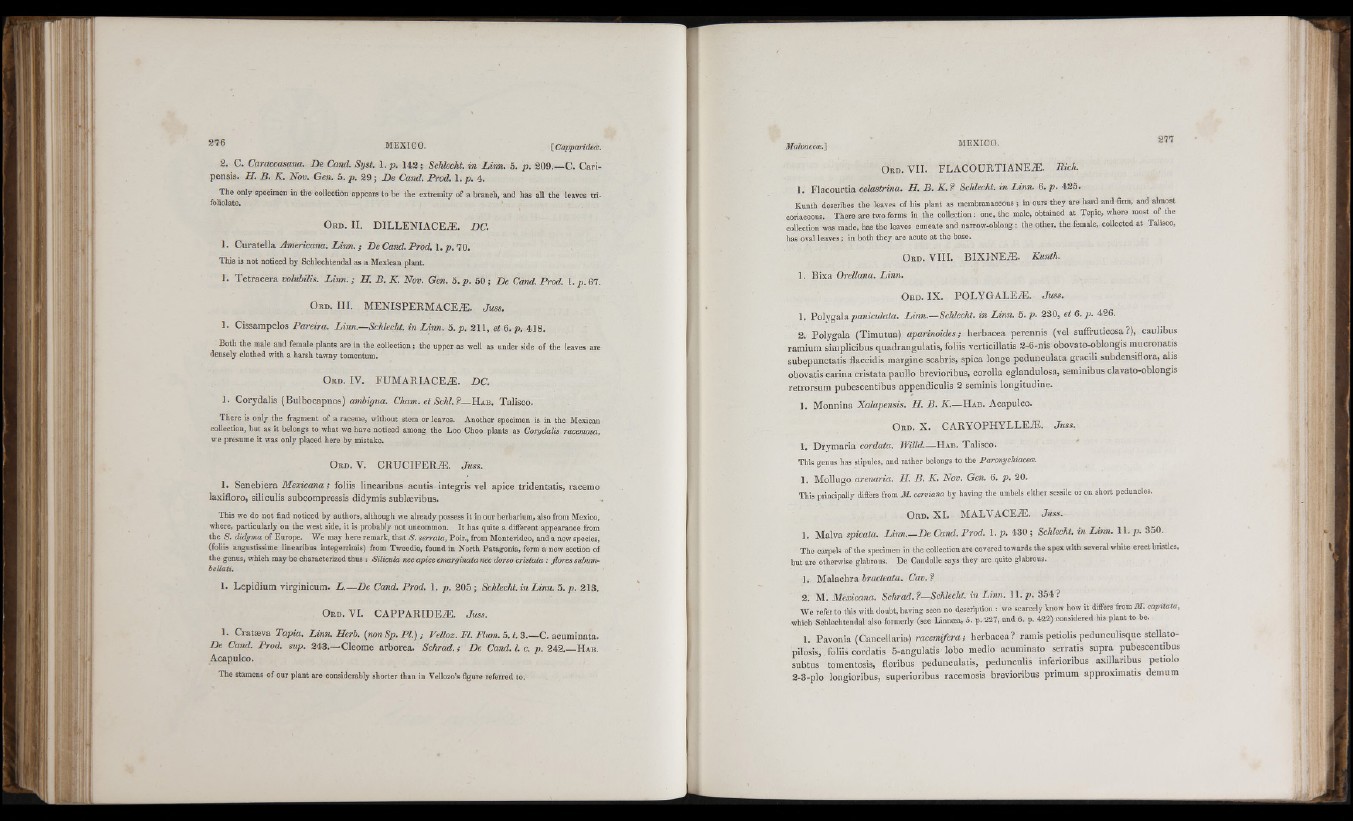
!
2. C. Camccasana. De Cand. Syst. 1. p . U 8 ; Schlecht. in Lirm. 5. p . 209.— C. Cari-
pensis. H . B . K . Nov. Gen. 5. p . 29 ; D e Cand. Prod. 1. p . 4.
The only specimen in the colleclion appears to be the extremity of a branch, and has all the leaves tri-
foliolate.
O e d . I I . D IL L E N IA C E Æ . DC.
1. CurateWa Americana. L in n . ; D e Cand. P rod. p . 70.
This b not noticed by Schlechtendal as a Mexican plant.
I. T e tra c e ra volubilis. L in n . ; I I . B . K . Nov. Gen. 5. p . 50 ; De Cand. Prod. 1. p . 67.
O r d . I I I . M E N IS P E R M A C EÆ . Juss.
1. Cissampelos Pareira. L in n .— Schlecht. in L in n . 5. p . 211, et 6. 418.
Both the male and female plants are in the collection; the upper as well as under side of the leaves are
densely clothed with a harsh tawny tomentum.
O r d . IV. FU M A R IA C EÆ . DC.
1 . Corydalis (Bulbocapnos) ambigua. Cham, et Schl.?— H a b . Talisco.
There b only the fragment of a raceme, without stem or leaves. Another specimen is in the Mexican
collection, but as it belongs to what we have noticed among the Loo Choo plants as Corydalis racemosa,
we presume it was only placed here by mistake.
O r d . V. C R U C IF E R Æ . Juss.
I . Senebiera M e x ica n a ; foliis linearibus acutis integris vel apice tridentatis, racemo
laxifloro, siliculis subcompressis didymis sublævibus.
This we do not find noticed by authors, although we already possess it in our herbarium, also from Mexico,
where, particularly on the west side, it is probably not uncommon. It has quite a different appearance from
the S . didyma of Europe. We may here remark, that S . serrata, Poir., from Montevideo, and a new species,
(foliis angustissime linearibus integerrimis) from Tweedie, found in North Patagonia, form a new section of
the genus, which may be characterized thus : Silicula nec apice emarginata nec dorso cristata : flores subumbellati.
1. L epidium virginicum. L .— De Cand. Prod. 1. p . 205 ; Schlecht. in L in n . 5. p . 213.
O r d . V I. C A P P A R ID EÆ . Juss.
1. Cratæva Tapia. L im i. Herb. {m n S p .P l .) ; Velloz. Fl. Plum. 5. acumìnaia.
D e Cand. Prod. sup. 243.— Cleome arborea. Schrad.; D e Cand. L e . p . 24% H a b .
Acapulco.
The stamens of our plant are considerably shorter than in Vellozo’s figure referred to.
O r d . V I I . F L A C O U R T IA N EÆ . Itich.
1. F la co u rtla celastrina. H . B . K. 9 Schlecht. in Lin n . 6. p . 425.
Kunth describes the leaves of his plant as membranaceous ; in ours they are hard and firm, and almost
coriaceous. There are two forms in the collection : one, the male, obtained at Tepic, where most of the
collection was made, has the leaves cuneate and narrow-oblong : the other, the female, collected at Talisco,
has oval leaves ; in both they are acute at the base.
O r d . V I IL B IX IN E Æ . Kunth.
1. Bixa Orellana. Lin n .
O r d . IX . P O L Y G A L E Æ . Juss.
1. Po\yga\a paniculata. L in n .—Schlecht. in L in n . b. p . 230, et 6. p . 426.
2. Polygala (T im u tu a) aparinoides; berbacea perennis (vel suffruticosa?), caulibus
ramium simplicibus quadrangulatis, foliis verticillatis 2-6-nis obovato-oblongis mucronatis
subepunctatis flaccidis margine scabris, spica longe ped u n cu lata gracili subdensiflora, alis
obovatis carina cristata p aullo brevioribus, corolla eglandulosa, seminibus clavato-oblongis
retrorsum pubescentibus appendiculis 2 seminis longitudine.
1. Monnina Xalapensis. H . B . K .— H a b . Acapulco.
O r d . X . C A R Y O P H Y L L E Æ . Juss.
1. Drym aria cordata. Willd.— H ab. Talisco.
This genus has stipules, and rather belongs to the Paronychiaceoe.
I . Mollugo arenaria. H . B . K. Nov. Gen. 6. p . 20.
This principally differs from M. cei-viana by having the umbels eidier sessile or on short peduncles.
O e d . X I . M A LV A C EÆ . J u s s .
1. Malva spicata. L in n .— De Cand. Prod. 1. p. 430 ; Schlecht. in L in n . U . p . 350.
The carpels of the specimen in the collection are covered towards the apex with several white erect bristles,
but are otherwise glabrous. De Candolle says they are quite glabrous.
1. y[a\ac\iva bracteata. Cav.?
2. M. Mexicana. Schrad.?—Schlecht. in L in n , 11. p . 3 5 4 ?
We refer to this with doubt, having seen no description : we scarcely know how it differs from M. capitata,
which Schlechtendal also formerly (see Linnæa, 5. p. 227, and 6. p. 422) considered his plant to be.
1. Pavonia (Cancellaria) raccm t/cra; b erbacea? ramis petiolis p edunculisque stellatopilosis,
foliis cordatis 5-angulatis lobo medio acuminato serratis su p ra pubescentibus
subtus tomentosis, floribus pedunculatis, pedunculis inferioribus axiUaribus petiolo
2-3-plo longioribus, superioribus racemosis brevioribus primum approximatis demum